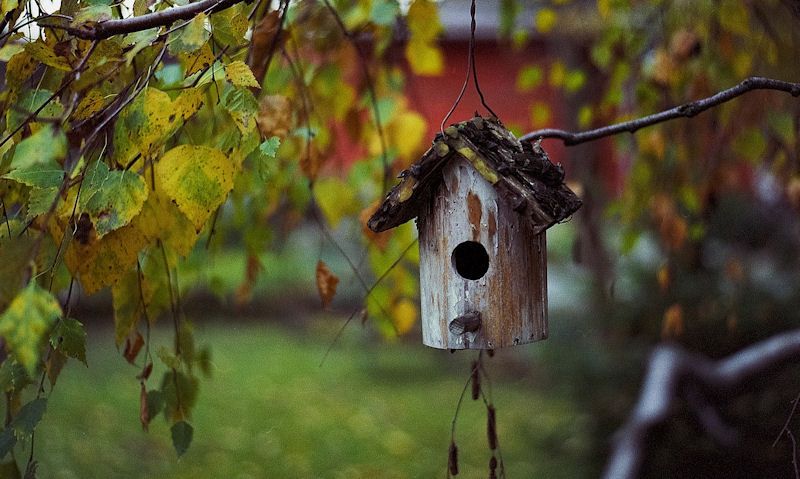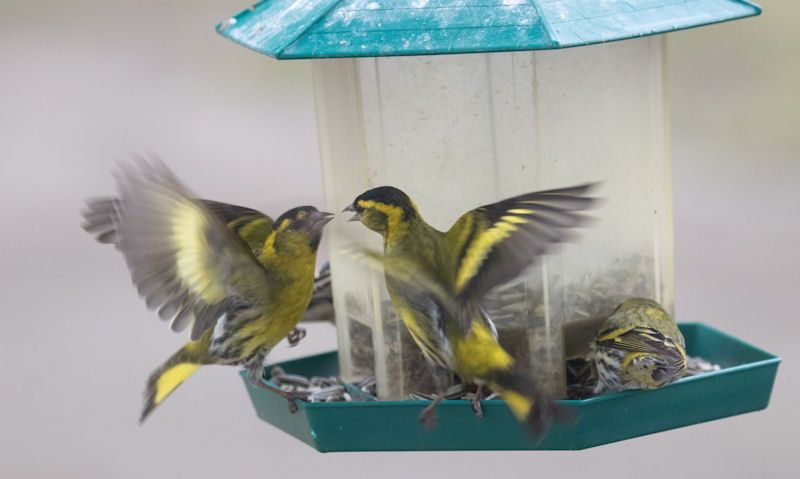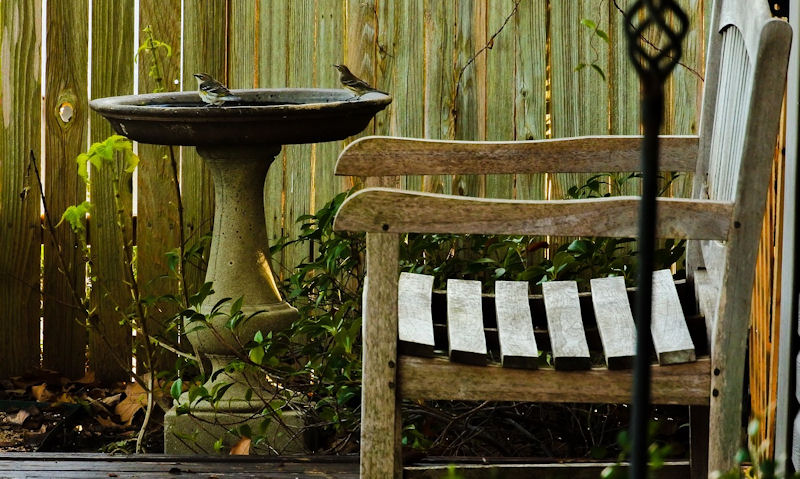Hanging bird feeder from tree
By using the natural cover of a tree, hanging a bird feeder up there would be the best possible site to fix a peanut, seed or fat ball feeder.
If hanging a bird feeder from a tree make it so you're within reach to refill or clean. Difficulty in hanging feeders comes from sliding the hook over the branch before pushing back down to the stronger side near the trunk. Don't use nails/screws, rely on rope only.
You're free to fix a bird feeder you'd normally hang off the bird feeding station, onto a tree that has an appropriate branch.
The branch in question should provide a smooth way for you to slide the hook on the end, before pushing it further up the branch to its strongest part - nearest the tree trunk.
If its not possible to slide the hook on before fixing the feeder, you could use various plastic coated wiring to swing over the branch, before tying it into a loop.
This loop will then act as an extension to hang the bird feeder off, rather then directly using the branch.
Higher up the tree the better but always make sure its out of reach of predators that may frequent the tree throughout the day.
You also need to observe where to place bird feeder so its out of direct sunlight, with the shaded side of the tree if it doesn't have much coverage.
Hanging light, commercially available bird feeders for use with seed, peanuts and fat balls is a breeze, well heavy bird tables need a stable branch to withstand the weight.
Hanging light bird feeders only
When we talking about hanging bird feeders from a tree, we're of course referring to hooking a hanging feeder only - not one that is designed to be mounted.
The use of a bird feeder that is designed to be hanged off the bird feeding station or off a bracket on the wall, are all made suitable for use with a tree.
And we're always talking about a sturdy, thick branch that is still fairly young, to prevent it breaking during use, or when the weight gets a bit much.
Its possible to secure a hanging feeder to a tree because its already setup with a purpose made hook, that only needs to be fixed over a branch.
One problem with that of course is the hook might not allow for your to thread it through from the end of the branch, up to a suitable area nearer to the tree trunk.
Its made more difficult if branches have additional, smaller branches hanging off which makes it rather difficult to slide the hook further up the branch to a safer spot where it thickens, rather than the delicate area on the branch end.
One way around this is the use of plastic coated wiring to extend the hook.
Hanging wooden bird tables
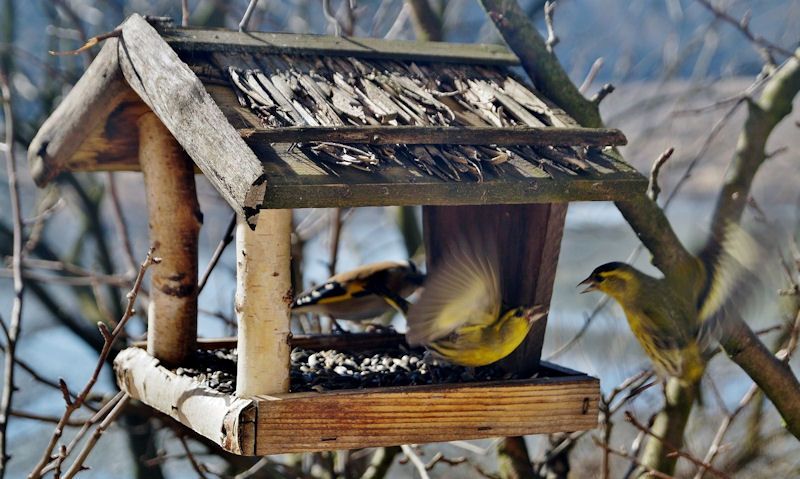
Well we're mostly talking about those long or short rounded tube seed feeders, mesh peanut feeder or caged fat ball feeder, a more durable branch will be needed for a bird table to hang.
In fact, those wooden hanging bird tables are only suitable for the thicker end of a branch, as feeding stations or brackets are not often compatible.
You see the wooden bird table that is made to hang is both large and heavy, with only a tree branch that can take such a feeder.
If fixed already with a rope - which it should be - just make sure the rope is a thick one and long, as this will not only protect the tree from damage but offer enough length to wrap around the widest branch on the tree.
How to hook on branch
So you've found the tree branch that is highly suitable for your peanut, seed or fat ball feeder - but there's one problem - its to thick for the feeders hook to wrap around.
Its also made further difficult if the branch is to high up, but still a branch you want to use.
Don't despair, there're ways around this with the use of additional, wider hooks that connect to the current hook in a sort of chain link.
If not, did you know you can unwire a metal clothes hanger to shape it into a hook to wrap through the hook that's on the bird feeder.
You would need to thread the wiring through the hook first, before tying it up once its wrapped around the original hook.
Easy to refill or clean
Remember, wherever you position the hanging bird feeder on the tree it must always be within arms length - providing you don't use a stole or ladder.
When the seed, peanuts or fat balls are running low, you need to be able to access the lid with ease to be able to refill with feed.
To high and you'll be forced to go through the bother off unhooking it, though if you refill the feeder without moving it all together, then better still.
And then there's those times when the feed has run out, and it needs a clear out before using again.
Well you might not be able to avoid unhooking it as it needs to be brought down to be cleaned thoroughly on the ground - soaking in a bowl of hot water with soap.
When fixing a bird feeder to the corresponding hook and hoop, just make sure you can remove the feeder without removing the whole thing off the tree.
Secure with coated wiring
If you're not in a position to use a customised wired coat hanger, a way around this is by using a plastic coasted wiring, similar to that used for a washing line.
Not only will this coated wiring last out in the elements, but its protected from rusting, thanks to the plastic, rubberised coating.
You would need to use a shorter length of wiring which should be just enough to create your larger hoop to wrap around the branch.
If you find yourself cutting the coated wiring to a shorter length, the metal wiring is now exposed so might rust, but it also has sharp edges so be careful not to cut yourself.
To create a fancy knot, research how to tie a noose that will allow for a perfect hoop, but at the same time allow for you to shorten/extend the hoop around the branch.
Creating a tighter hoop on a branch will help prevent the feeder from swinging or spinning around in high winds.
Clear flight path
When scouting a spot on your tree for a hanging bird feeder, make it so the branch in question has a clear flight path.
The flight path must have a clear line of sight so the wild birds can scatter on a side that has an open gap, though ideally you'd want multiple flight paths in all directions.
If positioning a feeder into the tree among many other branches, just make it one that is located further down.
That way the birds will be happy to exit from below them rather than across.
Don't damage the tree by breaking off branches to accommodate the feeder, you must find a spot that comes naturally.
Natural shelter from weather
Unlike bird feeders that are left out in the garden in the elements, the use of a dense tree should provide natural cover.
In the rain you should for the most part keep the food contained within the feeders dry, well always keeping it out of direct sunlight.
This only refers to spring, summer and autumn mind you as most trees are in full bloom, though if its a busy tree with lots of branches, the feeder should still have sufficient cover.
You could go one better by siting the feeder on the north/east side of the tree, this will help keep it shaded well avoiding strong, westerly winds.
Type of a tree
The type of tree used to secure a hanging bird feeder bares no issues for use with a feeder, nor are the plants or berries likely to cause harm to birds.
Well its unlikely the larger common trees found in parks are likely to be in your own; Ash, Sycamore, Beech, English Oak or Line trees.
Rather you'll likely to have a common small garden trees that has all that is good with larger trees, but in a smaller size.
As trees create natural shaded area in our gardens, if grown further away from the house this might help brings birds to it without fear of harm.
Don't worry though, they're sure to come to a tree if planted near a house window.
Where in the garden
If you observe the instructions used where to place a bird feeder in the garden, this will also apply to siting a feeder to a tree.
However, fixing a hanging bird feeder or table to a tree would be out of your hands as its only possible to hang where the tree it located.
Whether birds take to the feeder hung up in a tree will largely depend on if predators occupy the tree also, such as the squirrel using the bird feeder.
And that also applies to the pain in the backside pigeons using the feeder also, though a tree with lots of coverage should keep pigeons at bay.
If you're free of squirrels and pigeons, then its only the position of the tree that matters.
By that we mean if its in a quieter spot in the garden than great, but if your garden is a busy one with children and pets, then birds will stay away.
Saying that, on the quieter times birds are sure not going to pass up on a free meal.
Damage to tree
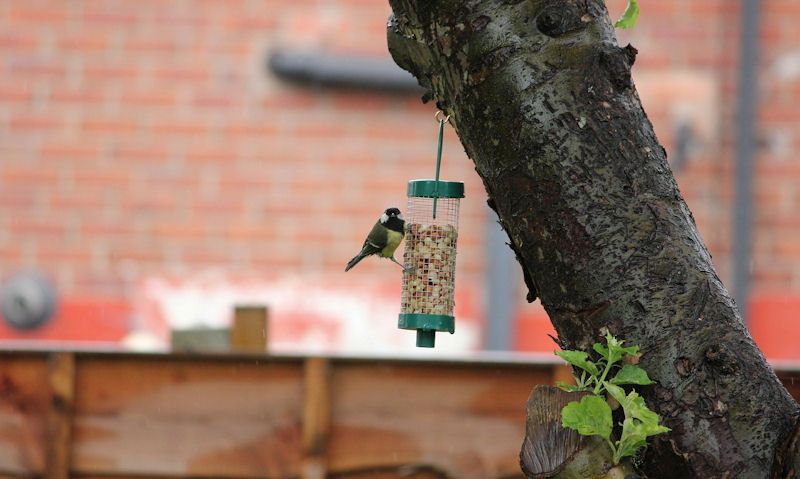
When fixing a hanging bird table to a young beautiful tree, you must do your very best not to damage the tree in the process.
Hacking a hole to thread the rope or wiring through is something you should never do, and so is the use nails or screws.
Likewise, the use of thin - cheese wire like - metal wiring will dig deep into the bark, eventually damaging it as it goes deeper over the years.
Think of it this way, a young, still growing tree has a long way to go before its has its full height and strength.
In this time the trunk and branches will thicken as they get stronger.
A tightly wrapped wiring that retains its width will see it embed in the tree to be never removed.
To avoid that, you need to create a noose so you can adjust the length over the years.
Use of nails or screws
One easy solution to fixing a hanging bird feeder to a tree is simply be hammering on a nail or to drill in a galvanised screw.
Sure both ways are a simple fix, but would do remarkable damage to the tree.
It won't be noticed right away, but exposing the trunk or branch to the elements will eventually takes it tall - as it dry's out, rots and decays over the years.
So instead, be inventive by avoiding nails and screws all together, or else you won't end up with a tree you can use.
Tree's have lots of branches and still tough twigs, so there must be one you can use.
Metal wiring
If you're not using a nails and screws, still thin metal wiring can still be damaging. If it can slice through cheese so easy, just think of what it will do to the tree bark.
If you're following our rules by tying a noose so you can increase the loop over time, this does not apply with the use of metal wiring.
Weight from the sometimes heavy peanut or seeds feeders are bad enough, but once they're filled to the top they get even more heavier.
This will over time force the wiring to penetrate into the tree branch; which is hard to observe from a ground view.
Thin, metal hooks
When buying a hanging bird feeder make it one that has a thick hook to hoop over the branch, but don't make it one that uses metal wiring.
Thin or thick metal, it will still make an imprint on the branch as the load gets heavier.
Thankfully, good quality manufacturers avoid using think metal hooks, instead choosing thicker stainless steel hooks that should be safe on trees - if you can get it to fit.
If not you'll have to extend the metal hooks with something a bit safer; shoe laces, metal chains or leather straps for example.
Conclusion
If you're hanging a bird feeder to a tree, or more specifically a tree branch, consider the health of the tree by not using hooks and hoops that will otherwise damage the tree.
You still need to take into consideration where the tree is located in your garden, therefore knowing if its a safe area for birdsto feed.
Trust us, regardless of the information you've read, wild birds will certainly give it a go to get at the food you offer them.
That's with the exception of tree's often occupied with squirrels, pigeons or cats; all of which will guarantee to keep birds away.
Providing natural cover, the trees foliage or dense branches will both keep the sunshine and rain away.
All common bird feeders can by fixed to a multitude of branch thicknesses, but you'll need to find the perfect one to hang a heavy, wooden bird table.
